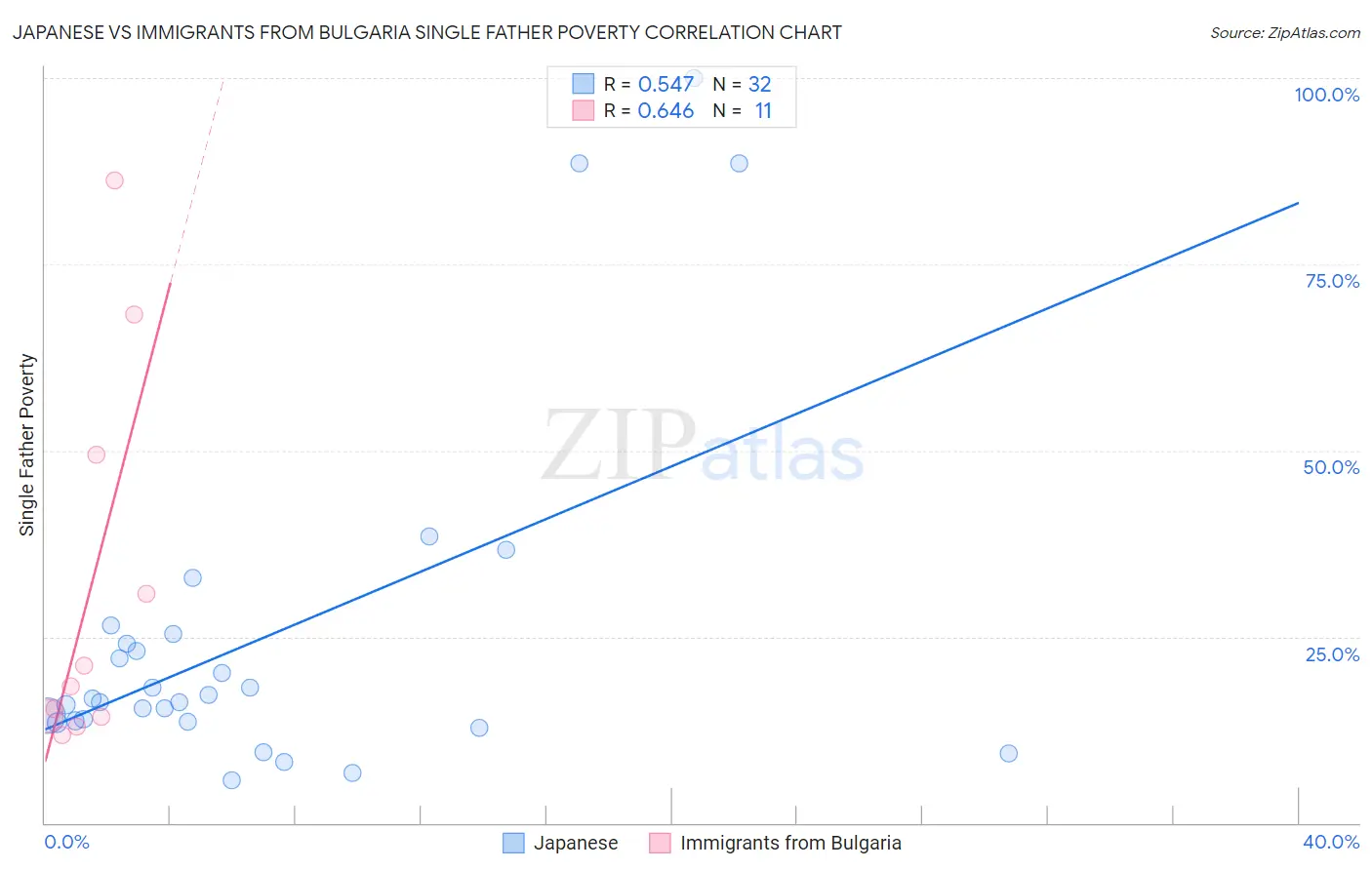Japanese vs Immigrants from Bulgaria Single Father Poverty
COMPARE
Japanese
Immigrants from Bulgaria
Single Father Poverty
Single Father Poverty Comparison
Japanese
Immigrants from Bulgaria
15.2%
SINGLE FATHER POVERTY
99.7/ 100
METRIC RATING
69th/ 347
METRIC RANK
15.0%
SINGLE FATHER POVERTY
99.9/ 100
METRIC RATING
55th/ 347
METRIC RANK
Japanese vs Immigrants from Bulgaria Single Father Poverty Correlation Chart
The statistical analysis conducted on geographies consisting of 212,212,459 people shows a substantial positive correlation between the proportion of Japanese and poverty level among single fathers in the United States with a correlation coefficient (R) of 0.547 and weighted average of 15.2%. Similarly, the statistical analysis conducted on geographies consisting of 145,942,181 people shows a significant positive correlation between the proportion of Immigrants from Bulgaria and poverty level among single fathers in the United States with a correlation coefficient (R) of 0.646 and weighted average of 15.0%, a difference of 1.5%.

Single Father Poverty Correlation Summary
| Measurement | Japanese | Immigrants from Bulgaria |
| Minimum | 5.7% | 11.8% |
| Maximum | 100.0% | 86.2% |
| Range | 94.3% | 74.4% |
| Mean | 24.9% | 31.2% |
| Median | 16.5% | 18.3% |
| Interquartile 25% (IQ1) | 13.6% | 14.3% |
| Interquartile 75% (IQ3) | 24.7% | 49.4% |
| Interquartile Range (IQR) | 11.1% | 35.1% |
| Standard Deviation (Sample) | 23.4% | 25.5% |
| Standard Deviation (Population) | 23.1% | 24.4% |
Demographics Similar to Japanese and Immigrants from Bulgaria by Single Father Poverty
In terms of single father poverty, the demographic groups most similar to Japanese are Immigrants from Cameroon (15.2%, a difference of 0.030%), Mongolian (15.3%, a difference of 0.10%), Paraguayan (15.2%, a difference of 0.11%), Immigrants from Moldova (15.2%, a difference of 0.20%), and Immigrants from Malaysia (15.2%, a difference of 0.23%). Similarly, the demographic groups most similar to Immigrants from Bulgaria are Immigrants from Uzbekistan (15.0%, a difference of 0.050%), Immigrants from Kenya (15.0%, a difference of 0.23%), Immigrants from El Salvador (15.0%, a difference of 0.26%), Immigrants from Laos (15.1%, a difference of 0.28%), and Laotian (15.1%, a difference of 0.36%).
| Demographics | Rating | Rank | Single Father Poverty |
| Immigrants | El Salvador | 99.9 /100 | #52 | Exceptional 15.0% |
| Immigrants | Kenya | 99.9 /100 | #53 | Exceptional 15.0% |
| Immigrants | Uzbekistan | 99.9 /100 | #54 | Exceptional 15.0% |
| Immigrants | Bulgaria | 99.9 /100 | #55 | Exceptional 15.0% |
| Immigrants | Laos | 99.9 /100 | #56 | Exceptional 15.1% |
| Laotians | 99.9 /100 | #57 | Exceptional 15.1% |
| Hawaiians | 99.9 /100 | #58 | Exceptional 15.1% |
| Guamanians/Chamorros | 99.9 /100 | #59 | Exceptional 15.1% |
| Puget Sound Salish | 99.8 /100 | #60 | Exceptional 15.2% |
| Immigrants | Bosnia and Herzegovina | 99.8 /100 | #61 | Exceptional 15.2% |
| Immigrants | Armenia | 99.8 /100 | #62 | Exceptional 15.2% |
| Immigrants | Sweden | 99.8 /100 | #63 | Exceptional 15.2% |
| Bangladeshis | 99.8 /100 | #64 | Exceptional 15.2% |
| Immigrants | Malaysia | 99.8 /100 | #65 | Exceptional 15.2% |
| Immigrants | Moldova | 99.8 /100 | #66 | Exceptional 15.2% |
| Paraguayans | 99.7 /100 | #67 | Exceptional 15.2% |
| Immigrants | Cameroon | 99.7 /100 | #68 | Exceptional 15.2% |
| Japanese | 99.7 /100 | #69 | Exceptional 15.2% |
| Mongolians | 99.7 /100 | #70 | Exceptional 15.3% |
| Immigrants | Brazil | 99.6 /100 | #71 | Exceptional 15.3% |
| Immigrants | Lithuania | 99.6 /100 | #72 | Exceptional 15.3% |